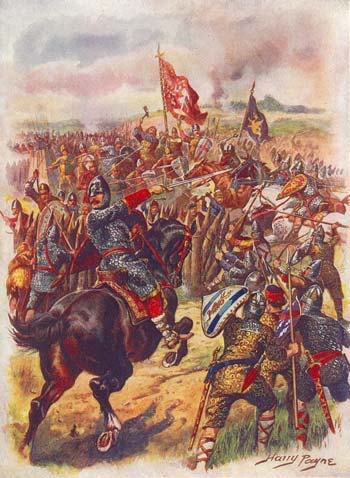
Welcome, wayfarer. If you’re new to my journey into gamerhood, you may want to read about how I got started with the world’s greatest hobby. Once you’ve read that novel-sized piece, you’ll likely want to learn what new-fangled 3D games influenced me during my turbulent teenage years before I move on to the end of the 32/64-bit era.
Last time, I concluded by mentioning that the 32-bit era had not yet ended, and that there was a brief period in which I experienced a dissatisfaction with video games. I had come off a high with Final Fantasy VIII, only to experience another short gaming drought. Sure, there was a new system called the Dreamcast, but I couldn’t afford one of those at the time of its release, and was saving my money for a DVD-playin’ PS2. Even though my gaming options for 1999 were as barren as the Sahara, I had a Pacific Ocean-sized oasis to look forward to. Being the RPG lover that I was, I was excited about the upcoming sequel (actually side-story would be more accurate) to Secret of Mana, a Chrono Trigger sequel, Vagrant Story, Threads of Fate, and Final Fantasy 9. Each of these games looked promising, and made me forget about some of the N64’s final gems.
Before moving on to those titles however, I’d like to briefly mention two Playstation games that had a monumental impact on me that were released before or concurrently with Final Fantasy VIII. These included the first of the legendary Metal Gear Solid saga and a remake of a Sega CD classic.
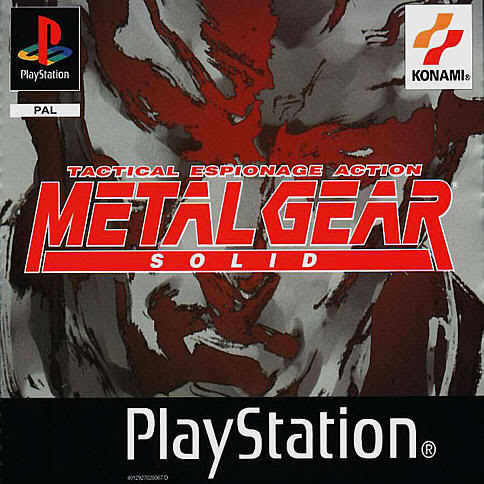
Metal Gear Solid is a franchise that is revered by millions of gamers, and hated by millions more. Even though the series now has many detractors, many of these haters fell for the original Metal Gear Solid as Meryl did for Snake. It was well-regarded for many reasons: it had realistic, albeit blue tinged graphics, an interesting storyline featuring an in-depth analysis of war, solid voice acting, and a moving musical score, in addition to innovative stealth gameplay.
Stealth gameplay had already existed for years (the MSX MGS games that few Americans played did it years ago), but 3D stealth games were still relatively new in 1998. Most action games at that point were run-and-gun experiences, so it was refreshing playing a title where your goal was to evade the enemy whenever possible. There were other stealth games out there such as Tenchu, but the difference here is that Metal Gear actually worked.
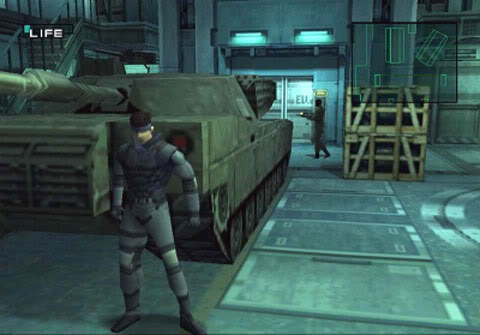
Sneaking around snapping necks and crawling through the snow was an unprecedented experience. MGS’ radar was extremely handy and allowed you to easily see your enemy’s field of vision. There were all kinds of tools at your disposal to evade and trick enemies, so the gameplay rarely got boring. Whether you were tapping walls or launching Nikita missiles around corners, there was rarely a dull moment to be had.
Metal Gear Solid’s boss fights were even more impressive. Whether you were taking on a tank single-handedly, being possessed by a psychic, or having a bare-chested brawl on top of a nuclear-equipped walking battle tank, there was never a dull moment to be had.
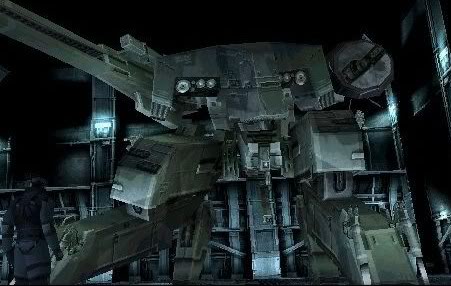
Some of my favorite moments involved a certain cyborg ninja coming to your rescue, watching soldiers pee their pants in fear, and having your mind read by Psycho Mantis. Psycho Mantis was the only capable psychic I knew of at the time (he knew that I played Castlevania and Suikoden!).
When I wasn’t fighting Metal Gear’s assortment of freaks, I was enjoying the narrative that examined aspects of war that are often ignored. Most war games simply involve picking up a gun and mowing your enemies down, or conquering neighboring regions from the perspective of a god. While these may make for fun gameplay experiences, they’re not exactly a realistic take on war.
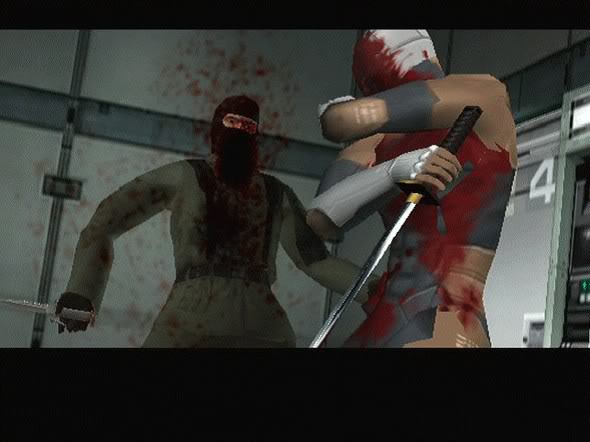
In video games (or movies for that matter), war is rarely covered from a humanistic perspective. Personally, I loved how Solid Snake never saw himself as a hero. He brought to light that killing never feels good. I’ve often heard people say things like, “Let’s kill those towel heads” or “Let’s wipe out those commie bastards,” but rarely do I hear them speak with concern for people different from themselves.
Regardless of whether you believe in someone else’s ideology, the fact of the matter is that people on the other side are human beings too. Innocent victims are always hurt through warfare, and Metal Gear does a great job detailing this.
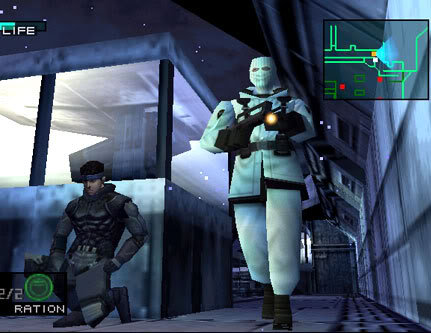
Besides being a humanitarian piece and a political thriller, I also admired Metal Gear Solid’s top notch voice acting. By 1998, I’d seen voice acting before (games like Command & Conquer and Star Fox 64 immediately come to mind), but never had I seen it done so well. Snake’s gruff voice, affected by years of cigarette smoke, really matched his persona. You could also feel Meryl’s compassion for other people and sense her confusion through her voice. Even characters like Psycho Mantis wouldn’t have been as believable without their excellent voice work.
Metal Gear’s solid voiceovers may have changed my outlook on voice acting in video games, but the beautiful musical score also floored me. Never before had I felt as moved by video game music that wasn’t from an RPG. I can still remember feeling tense whenever the alert music would play. I also remember feeling sad after slaying Sniper Wolf, partly due to the somber music that was being played. Every song really matched the tone of each area, and the bar had been raised for all future action games.
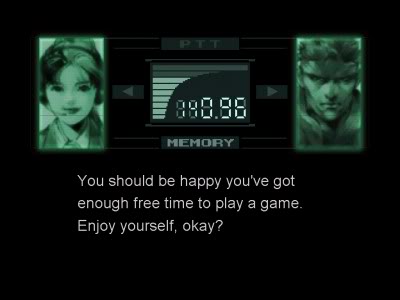
As you can tell, Metal Gear Solid had a profound impact on me, but a game that I enjoyed even more came out of nowhere. If you’ve read my other entries, you’re already aware that I’m quite the RPG fan, but I’d missed out on a number of titles that weren’t produced by Square. One of these was a classic released by Game Arts for an obscure system add-on called the Sega CD. Before reading an EGM review, I’d heard nothing of the anime-inspired RPG called Lunar.
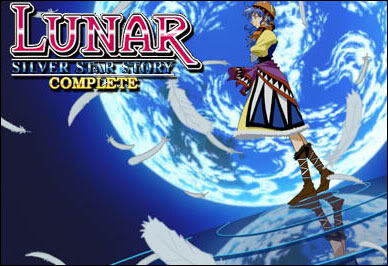
During the summer of 1999, I didn’t have much to do. I was involved in a number of activities, but I often had to stay inside due to my terrible allergies. Final Fantasy VIII was on the horizon, but I’d beaten most of my other games, so I was quite bored. After reading about an ancient-looking RPG called Lunar Silver Star Story Complete, I decided to bike to the local Fred Meyer. Once I got home, I was treated to a surprise: A singing intro.
Initially, I found the intro song kinda corny, but I loved the anime cutscenes that led me to believe this was a grand adventure. Just for the record, I was never an anime fan, but something about Lunar’s art style drew me in. By the time of its mid-1999 release, I’d grown accustomed to dystopias or worlds on the brink of ruin, so it was refreshing to see such a colorful and light-hearted game.
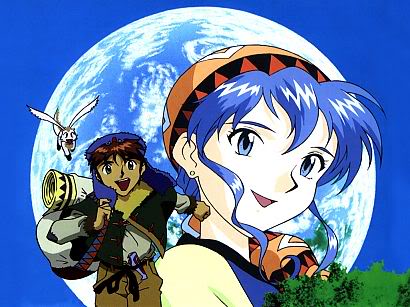
Once I actually started the adventure, I was immediately drawn in by the simple narrative. The main character, a teenage boy named Alex, lived in a peaceful hamlet called Burg with his adopted friend named Luna. You initially don’t know much about both of these characters, but you soon learn that Alex has aspirations of following in the footsteps of his idol: Dragon Master Dyne.
Dyne was a great hero who’d previously saved the world from the encroaching Vile Tribe, and Alex had dreams of becoming a great Dragon Master himself. In order to do so, he’d need to seek out the four dragons that protected the land, and the heroes that initially saved the world from destruction.
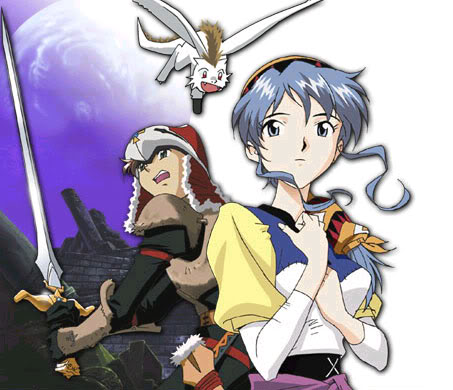
Alex’s dreams of grand adventures finally came true when the donut-lovin’ con-artist named Ramus approached him. They initially planned to sneak off without Alex’s friend Luna, but like every girl, she didn’t want to be left out. Alex and Ramus tried to ditch her, but they reluctantly accepted her once they needed the songstress’ magical powers.
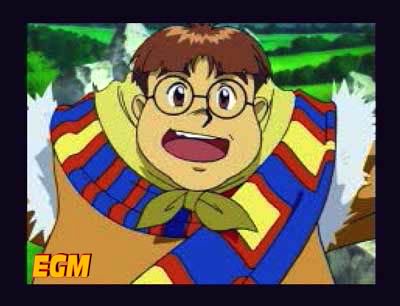
So the adventure starts out with typical RPG fare, but part way through the game, there’s a surprising plot twist that turns the adventure on its head. Instead of simply seeking out the dragons, you now have to save Luna from the Magic Emperor threatening the land. That alone probably doesn’t sound interesting to most people, but the subtle details are what make Lunar special.
Even though Lunar’s overarching story is fairly simplistic, I loved the underlying themes. The Magic Emperor, or Ghaleon, was one of the four heroes who previously saved the land, but you later find that he plunged the world into darkness, because he didn’t believe in the Goddess Althena’s intentions.
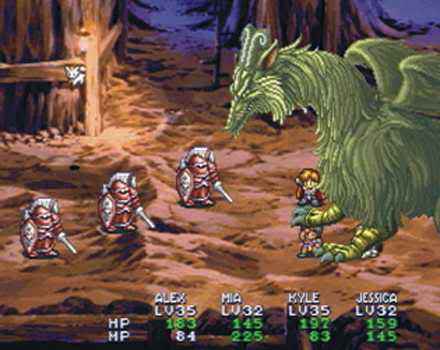
See, the world of Lunar was formerly protected by an all powerful goddess. After banishing the Vile Tribe that had previously threatened the land, she decided that humanity should be allowed to govern itself and decide its own destiny.
Ghaleon found this fool-hardy, and decided that an all powerful monarch or god was needed to keep ignorant, self-serving beings in check (quite the hypocrite, isn’t he?). His compatriot, Dyne, thought otherwise, and sided with Althena in her wishes. He believed that democracy was the ideal form of government, and that people should be allowed to govern themselves, regardless of whether they are responsible or not.
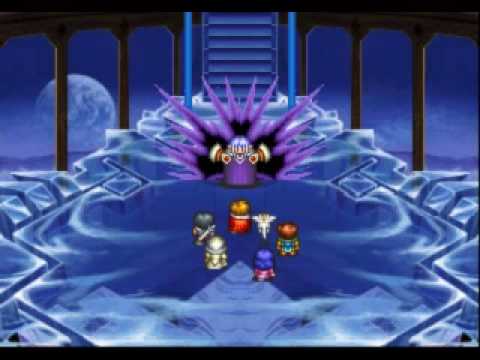
I appreciated these aspects of the plot, not only because they provided some motivations for the villain, but because they have connections with the real world. Throughout history, there have been those who’ve questioned whether people are really responsible enough to govern themselves. In the United States of America, most people believe that democracy is the ideal form of government, but there are still those who believe that the majority of the populace is ignorant. Lunar tackles this in addition to religious issues that run parallel to important messianic figures like Christ.
Obviously, I found Lunar’s story quite interesting, but what really set the game apart from other RPGs was its incredible localization and dialogue. Working Designs really went all out when translating this RPG. Each person you talk to in the world of Lunar has at least four different things to say, and most of them are quite humorous. Some players didn’t like the American humor involving Wheaties and Bill Clinton, but others appreciated the change, and grew attached to the world as a result.
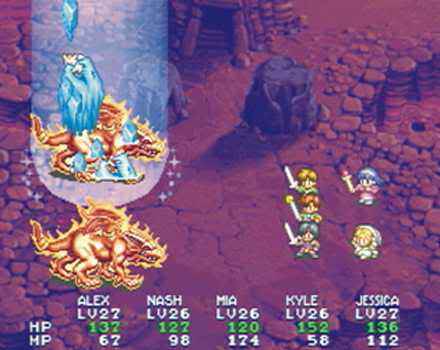
Regardless of whether or not players appreciated the altered humor, it’s nearly impossible not to laugh at characters like the fish-lovin’ Nall. I found the characters quite loveable, much like Calvin and Hobbes from the renowned comic strip. By the end of the journey, I’d grown attached to the majority of the characters, and felt quite sad after parting with some of them.
I still remember the accompanying Making of Lunar CD where the creators of Lunar felt touched that so many people were affected by Lunar’s moving story. I didn’t cry like some of the players that had written in, but I can’t deny that I was impacted by the game.
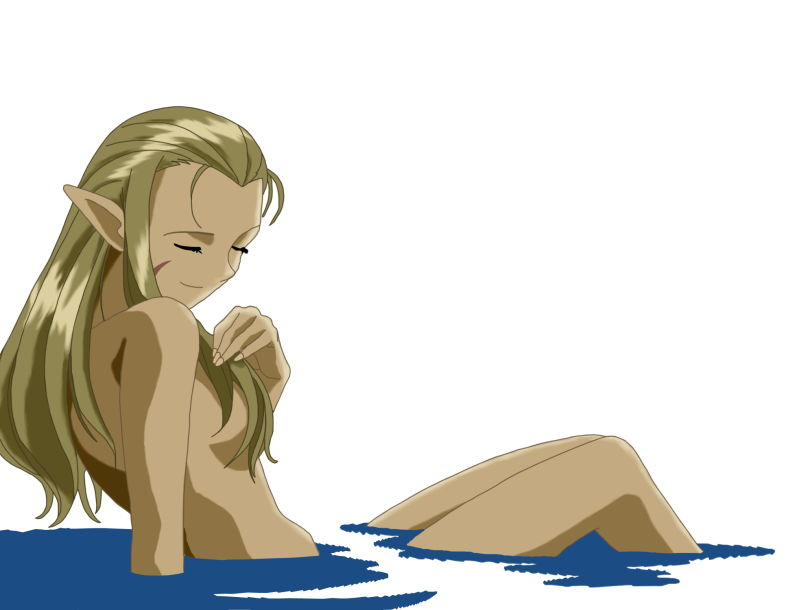
Lunar also featured a wonderful, upbeat soundtrack, and an innovative turn-based battle system where characters could move in battle, but I felt that the dialogue, story, and artwork were the standout pieces of this well-rounded package. With each of its elements being so incredible, it’s hard to believe that Lunar featured some of the best packaging I’d ever seen in a game.
Collector’s Editions are now commonplace, but I’ve yet to see one that rivals the goodies that Working Designs released. Lunar’s amazing packaging featured gorgeous anime artwork, a soundtrack, a Making of CD, a cloth map, and an impressive leather-bound manual. Now that I actually have room to display my games, it has a prominent position on my shelf filled with gaming paraphernalia.
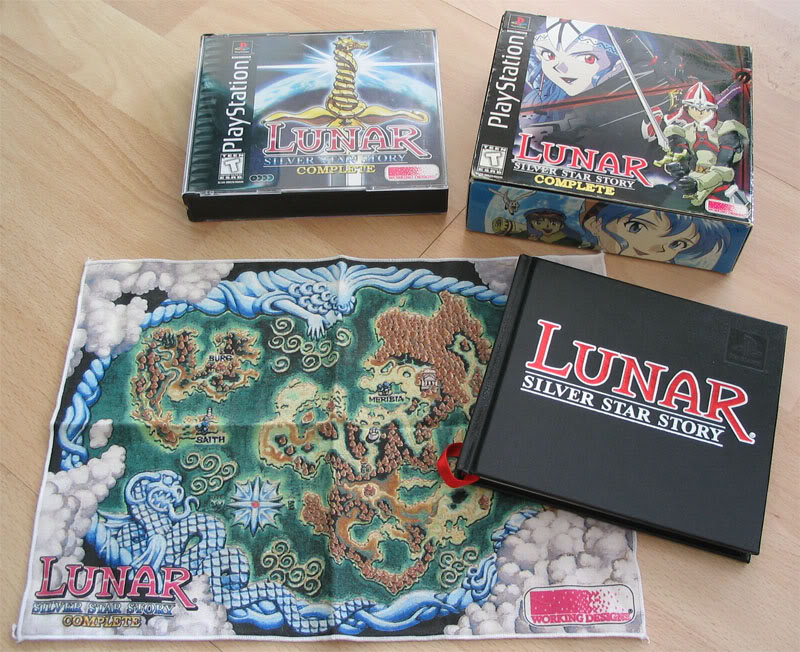
Well, I clearly got carried away with the Playstation titles I forgot to mention last time, but now it’s time to reminisce about one of my favorite years in video game history: The Day of Lavos, or Y2K.
As mentioned earlier, the year 2000 had enough high quality releases to keep a gamer busy for a lifetime. The first game I thought I’d love actually ended up being eclipsed by a turn-based strategy game featuring giant mechs.
I was eagerly awaiting Vagrant Story, because it was developed by much of the crew who’d worked on Final Fantasy Tactics, and because it bore a striking resemblance to the stealth-action classic, Metal Gear Solid.
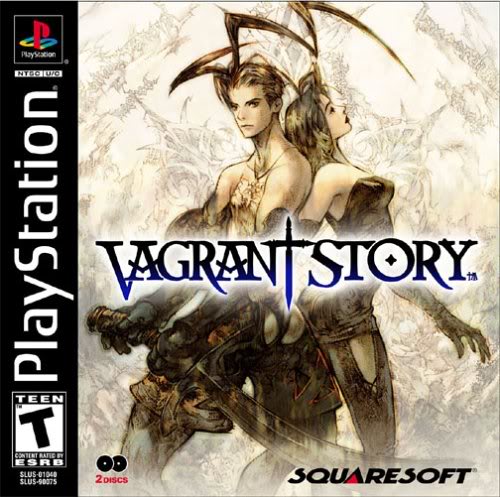
Even though it featured an androgynous main character and villain, and featured graphics saturated with brown, I thought that I’d be impressed with what Vagrant Story had to offer. The plot seemed like it would be another political thriller set in medieval Europe, and the game was accompanied by an amazing soundtrack, but the constant dungeon crawling and convoluted battle system ruined the experience for me. Don’t get me wrong, I appreciate complexity, but not when the game requires a FAQ to be playable. Some gamers may call me a “n00b,” but I gave this game that I wanted to enjoy a fair shake, and I left unimpressed.
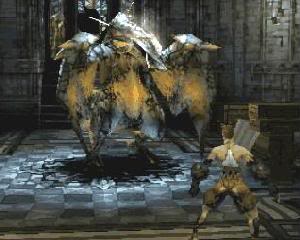
Fortunately, another early Spring release featuring enough German words to get you through German 101 managed to impress. Final Fantasy Tactics made me fall in love with Strategy RPGs, so I decided to give a supposedly similar game featuring mechs a shot. EGM seemed to love Front Mission 3, so I figured I’d feel the same.
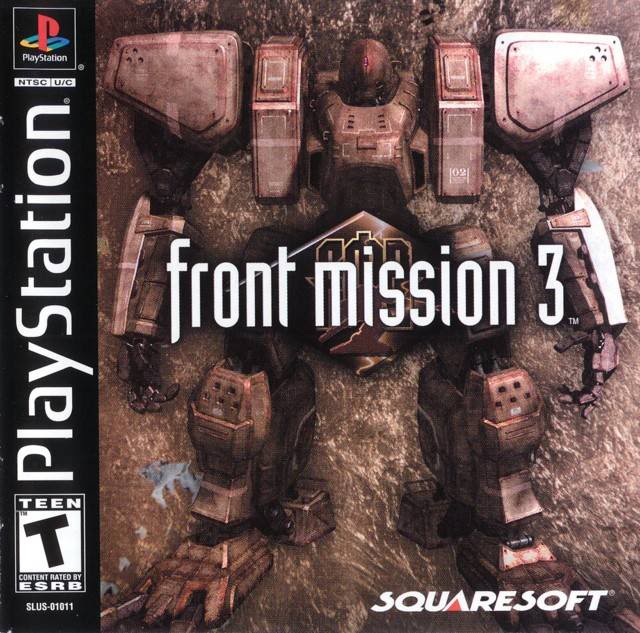
Well, I didn’t have as much fun as I did with FF Tactics, but I really enjoyed customizing my Wanzers and laughing at the goofy characters with my former best friend. He was quite immature, and would typically try to turn all Japanese words into swear words, so I had to deal with plenty of that while playing Front Mission.
Instead of taking the game too seriously as I usually did, I decided to make fun of characters like Ryogo who’d often make an ass out of themselves. Ryogo, was a goofy sidekick of one of the main characters (Kazuki), and he’d typically make cocky comments regarding women and his prowess on the battlefield. My friend and I knew he was a good BSer, so we laughed when he finally got stomped by the enemies.
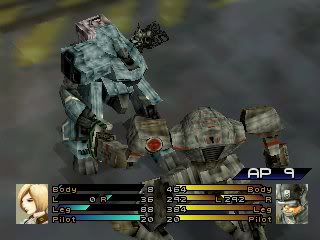
I can’t say that Front Mission 3 had as much of an impact on me as many other games of the Playstation era, but its off-the-wall humor and its two, thirty-hour scenarios provided for hours of entertainment.
Front Mission and Vagrant Story weren’t all they were cracked up to be, but they bought me some time to prepare for 2000’s summer RPG onslaught. Squaresoft even created a special promotion for three of its biggest games including: Legend of Mana, Threads of Fate, and Chrono Cross. They called it: The Summer of Adventure.
As a rabid fan of the Mana and Chrono games, I was eagerly awaiting these sequels to two of my favorite franchises. Legend of Mana would be the first console game I’d enjoy during the summer before my Sophomore year of high school.
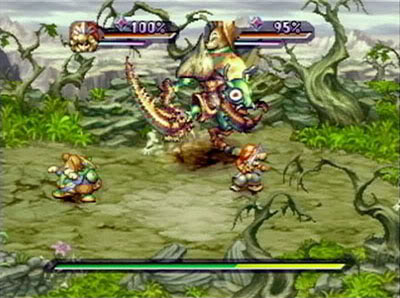
I was expecting great things from LoM, because Secret of Mana had long been my favorite Action-RPG. At the time, I was only aware of two games in the series (Final Fantasy Adventure and Secret of Mana), and I enjoyed SoM the most because of its deep combat system, multiplayer gameplay, and beautiful music. Legend of Mana got part of the equation right–it featured a beautiful soundtrack along with stunning hand-drawn artwork, but the dumbed-down gameplay felt like drinking your best friend’s backwash.

Legend of Mana had some interesting concepts: it featured non-linear progression and several modes in which you could create your own objects, but the core gameplay just wasn’t much fun. Unlike Secret of Mana, it was a strictly side-scrolling experience full of button-mashing gameplay. I missed the variety of weapons from Secret and the charge attacks, so only the fabulous music and artwork kept me going.
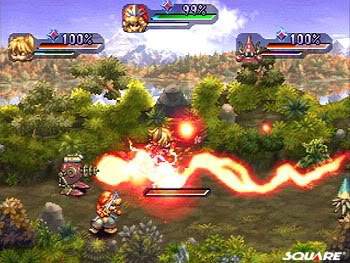
Square also missed the mark with LoM’s multiplayer. A second player could join in on occasion whenever you received a temporary character, but he would constantly change characters, so your buddy would never really grow attached to the experience. Legend of Mana wasn’t terrible–I’ll never forget Yoko Shimomura’s brilliant soundtrack, but unfortunately, it’ll always feel like a scar that never goes away.
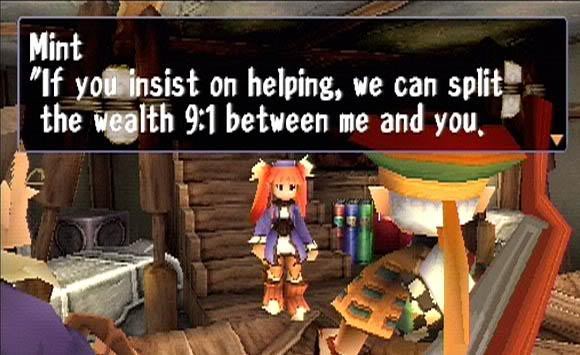
The next Summer of Adventure game was even more disappointing. I’d hoped that Threads of Fate would be Secret of Mana in 3D (as I’d wished with Brave Fencer Musashi before), but once again, Square kicked me in the balls. Threads of Fate wasn’t terrible with its two character gameplay system and smooth polygonal graphics, but the combat system felt like a simple hack ‘n slash. That kind of gameplay wasn’t enough to satisfy me, so I eagerly awaited Chrono Cross.
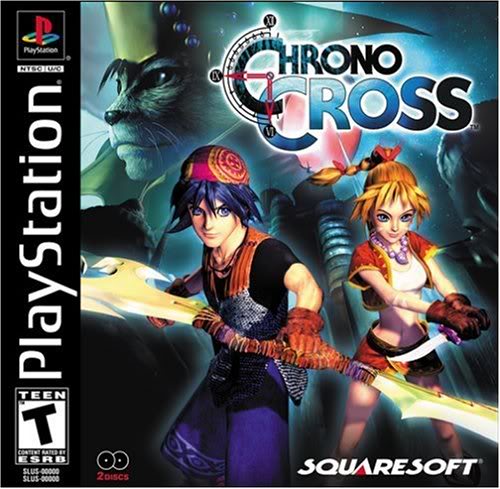
Unfortunately, I was visiting my neighbors to the north who say funny words like “aboot” at the time of its release, but when I got back, I quickly headed to Software Etc. to redeem my pre-order. My friend Max had already been playing Chrono Cross, so I was eager to catch up with him.
I initially wasn’t expecting much from Chrono Cross, because it didn’t feature the loveable artwork of Akira Toriyama and had a new cast of characters, but EGM gave it two 10’s and a 9.5 (damn you Sewart), so I knew it had to be something special. My friend Max’s relationship with Chrono Cross wasn’t that great–it left him feeling like he was dumped by the girl of his dreams, but I quickly grew attached to its two black discs.
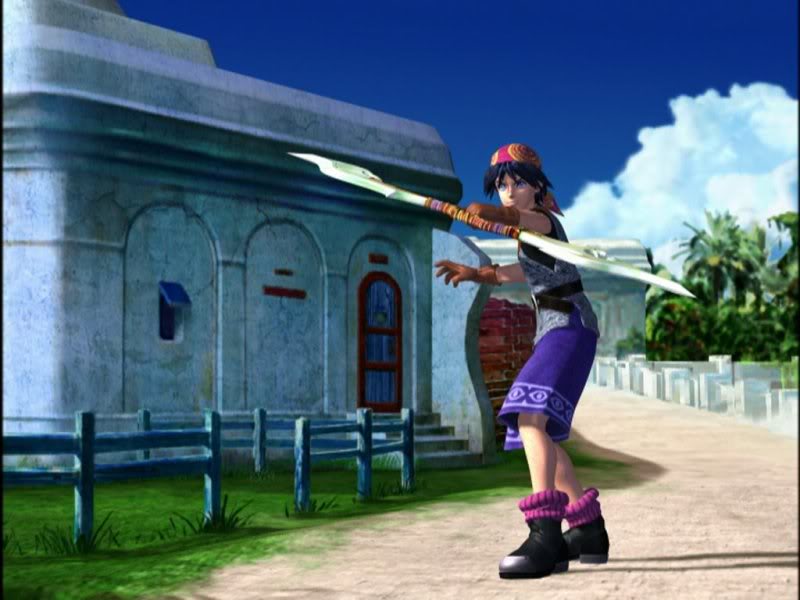
Despite not including Crono and his posse, I loved the story, characters, artwork, and music. Many things about Chrono Cross astounded me, but I was most impressed with the music. The opening theme with all its string and Celtic instruments immediately drew me in. I’ll never forget that incredible theme that accompanied the turning of a book’s pages. Two years ago, I was fortunate enough to witness a large group of beautiful females dancing to that wonderful song. They probably didn’t even know that it was from a video game, but nevertheless, I felt like I was in Heaven.
That wasn’t the only song that moved me. Chrono Cross also featured many sad piano pieces that really tugged on my heart-strings. I also loved the tropical music that really matched the game’s aesthetic. Even more impressive was that the Chrono Cross team managed to incorporate some of my favorite Chrono Trigger tunes into a few of the game’s songs.
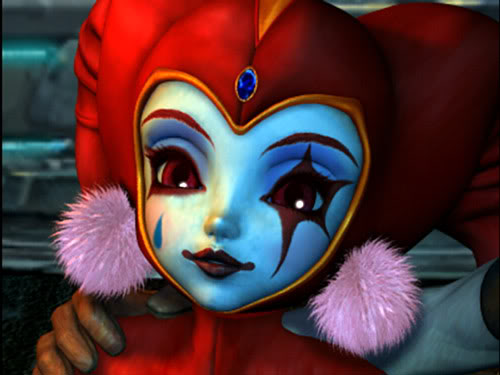
Nine years later, I still haven’t played a game with a soundtrack that rivals the amazing compositions found in Chrono Cross. I’m still hopeful for the future, but with quality original soundtracks being neglected in favor of voice acting, I’m not sure if my dream of a soundtrack surpassing the one found in Chrono Cross will ever come to fruition.
Besides CC’s soundtrack, I was also impressed by the game’s organic artwork. I borrowed that term from an EGM review, but really, it’s true. FFVIII may have been a looker, but Chrono Cross’ environments managed to reflect the beauty of nature in a way that hadn’t been done before. The serene, tropical environments all had a natural look that was unrivaled on the Playstation.
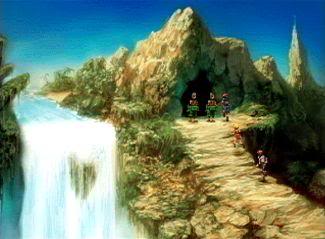
Even the character artwork and animations managed to impress. Chrono Cross’ forty different characters had far more personality than many of the RPGs today that feature six characters. Serge’s blue hair and calm nature reminded me of Crono. Sure, he wasn’t the most talkative character, but I liked him enough to choose Sergio as my name in Spanish class. With characters that include burly knights, iron chefs, and spear-hurling nomads, you’d be crazy if you didn’t like any of them.
Each of these characters had a variety of animations and unique attacks. Some of them could even combine to perform double or triple techs as in Chrono Trigger. Their attacks certainly impressed, but the creative battle system had more of a lasting impact.
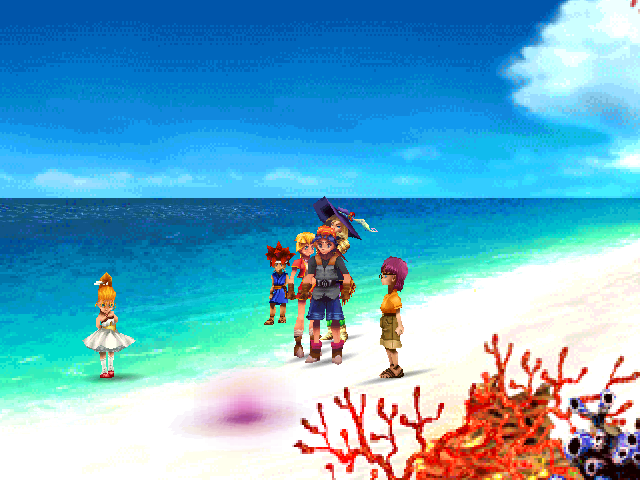
In Chrono Cross, characters could perform weak, medium, and strong attacks, which is similar to Xenogears, but the difference here is that weak attacks had a better chance of connecting with an opponent. When beginning a battle, each of the three levels of attacks has a different percentage of success. Strong attacks are less likely to hit, but you’ll have a better chance of succeeding if you input a weak or medium attack first. These attacks not only vary in the amount of damage they inflict, but they also can raise your magic level, so you’ll be able to unleash that devastating fire attack.
Chrono Cross’ magic system was quite strange, in that you purchased (or found) elements to equip on your character. The more bosses your character had fought, the higher level of spells she’d be able to equip.
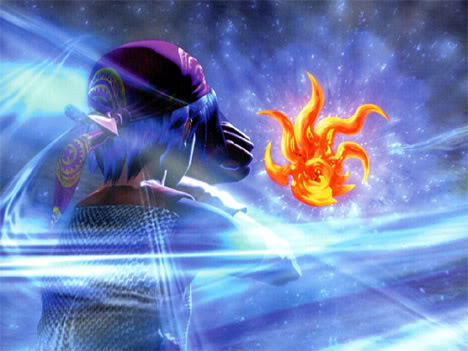
These could only be casted by performing physical attacks that would give you a certain amount of points, depending on their strength. Strong attacks would give you three points, while weak attacks would give you one. A weak attack would provide you with enough to cast a basic spell, but it’d be important to strike your foe with a series of powerful attacks over the course of a couple turns to cast a level eight spell. This system was quite flexible, and provided for some interesting gameplay. Square-Enix’s Final Fantasy XIII would later borrow from this innovative battle-system.
Also unique to Chrono Cross was its leveling system and boss encounters. In Chrono Cross, you could see enemies on-screen (as with its prequel), so you only had to fight when you wanted to. Even better was that Chrono Cross threw out the tedious process of gaining levels. Now, you could choose when to fight, and usually, you were only forced to fight bosses. This system cut down on one of the most tiresome processes of RPGs, so I found it rather refreshing. However, there were some advantages to fighting regular enemies. Occasionally, they would drop useful items and elements, and would add minor stat bonuses, but they were mostly just there for the gamer who wants to max out his party.
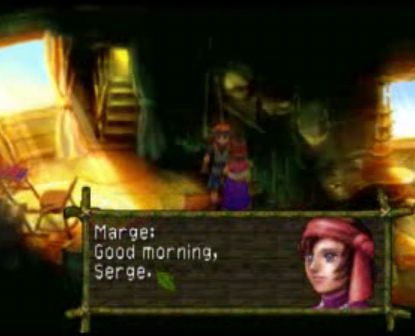
Besides not having to gain levels, you could also run from bosses. How many times in an RPG have you entered a boss battle unprepared? If you’re being honest with yourself, it’s probably happened at least a dozen times. If you’re someone who frequently forgets to bring your papers to class, Chrono Cross has your back, as you’re able to regroup and bestow your fearsome foe with an ass-kicking.
I’m mostly done with Chrono Cross, but the last way in which this tropical game influenced me is with its storyline. It may not feature the cast of Chrono Trigger, it might have a slower-paced battle system, and it may include the goofily named Solt and Peppor, but its storyline is one of the most interesting to ever grace a video game. Some may find it overly complex and wordy, but its time-spanning, multi-dimensional plot enthralled me from the beginning until the very end.
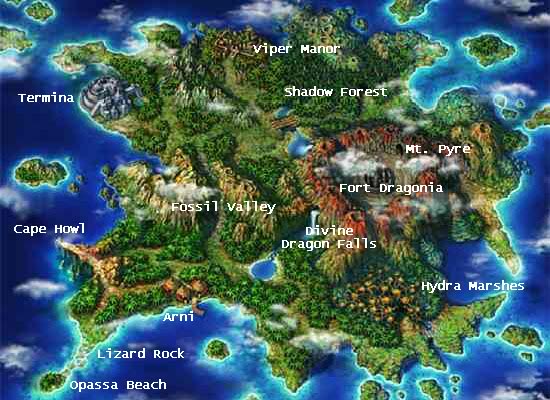
I especially enjoyed how Chrono Cross tackled some of the darker aspects of time travelling. In Chrono Trigger, the possible negative consequences of Crono’s actions were rarely discussed. Chrono Cross on the other hand, reveals multiple potential realities, and some of them are quite scary.
Chrono Cross’ take on Fate was also quite interesting. Many religions and philosophers have pondered whether or not events in our world are pre-determined, and Chrono Cross tackles this subject in great detail.

It was also interesting seeing how the events of Chrono Trigger were interwoven into the story. Chrono Cross took place twenty years later on a separate archipelago, so the connections were limited, but there were still enough to make Cross feel like a true Chrono game. Some of the events that befell characters like Lucca were quite tragic, but it was still nice to discover what happened to them.
Also, there were plenty of openings for players to use their imagination involving events such as the ascendancy of a small Chrono Trigger village known as Porre. To be blunt, Chrono Cross is a thinking man’s game (much more so than Chrono Trigger), and that’s one of the main reasons why I enjoyed it.
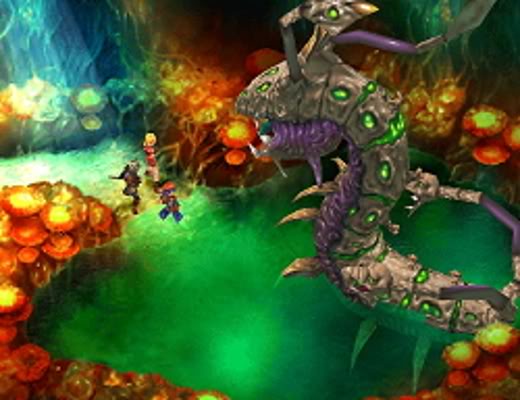
Now that I’m done reminiscing about Square’s Summer of Adventure, it’s time to reveal why I was temporarily dissatisfied with video games. After completing Chrono Cross, my best friend Max and I got into an argument regarding the game’s quality. He felt that it didn’t live up to Chrono Trigger, but he was especially bitter that he was unable to see Chrono Cross’ true ending. Unfortunately, players can miss the real ending by ignoring the battle instructions given before fighting the final boss, and sadly, Max fell victim to this trap. He’s a person that easily gets frustrated, and that combined with his new love for PC games like Starcraft and Diablo II made him lose interest in RPGs.
I was going through a similar phase. Once my family got a decent computer during the year 2000, I plunged into online gaming along with some of my friends, so I’d begun to lose interest in single-player experiences. Also, I started to become more concerned with my reputation. I was never one to proclaim my love for video games at school, but certain individuals had me interested in “cool” games like Grand Theft Auto III. I did try some of these new titles once they were released, but thankfully, an issue of EGM rekindled my interest in RPGs.
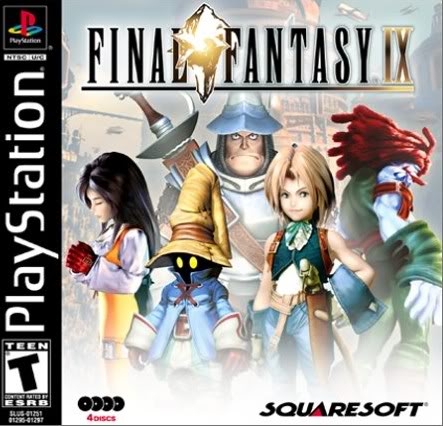
The Final Fantasy 9 issue of EGM left me drooling. Even though I really enjoyed FF7 and FF8’s sci-fi aesthetic and increased emphasis on cinematics, I yearned for the days of old. I missed wooden airships, knights that actually looked their part, and moogles that actually said, “Kupo!” Even though there would later be a character name change (Salamander to Amarant), I was psyched for this hybrid of amazing cinematics with a fantasy world full of magic and crystals.
Unfortunately, the three month wait tested my patience, but ultimately, I’m glad that I held out, because Final Fantasy 9 immediately became my favorite game in the series. Part of my love for this title was due to the incredible cast of characters.
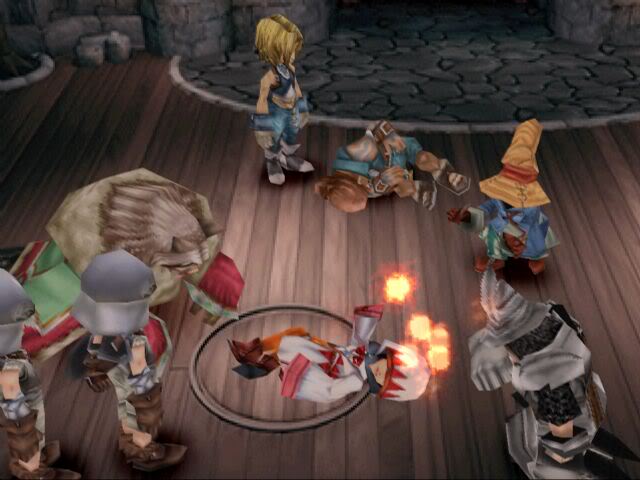
Don’t get me wrong, I liked Cloud and Squall, but I really admired Zidane’s friendly attitude and mischievous nature. He may have been somewhat of a perv, but his likeable personality made me replace Locke as my favorite thief. I also quickly grew attached to the overly-shy Vivi and the clumsy knight, Steiner.
First of all, I’ve always found black mages charming, but Vivi’s caring nature made him a loveable character, despite his limitations. I especially admired how he never gave up, even though FF9’s black mages were viewed as soulless creatures.
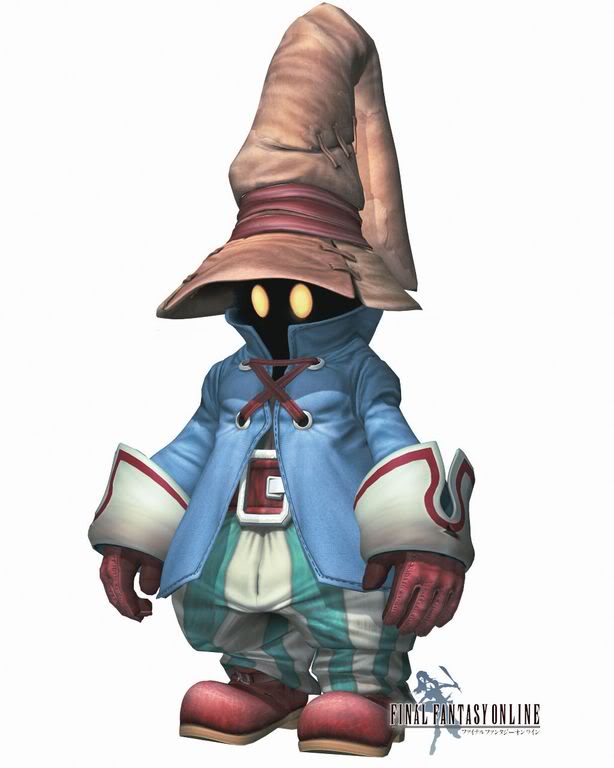
I also particularly liked Steiner. He may have looked like a villain from Brave Fencer Musashi, but I loved how he’d often act without thinking. Watching him make countless stupid mistakes quickly made him my favorite big oaf.
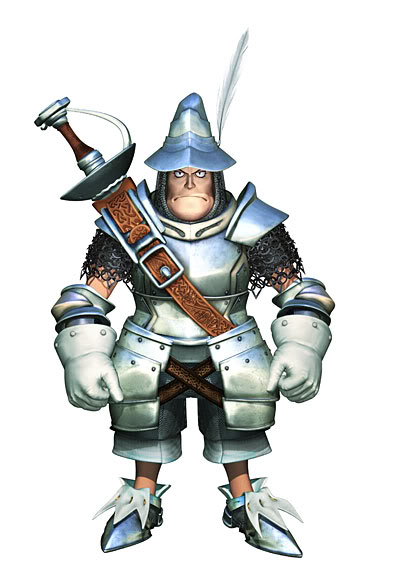
The rest of FF9’s cast was great as well (even the gender-bender that is Quina), but now I must discuss how Hironobu Sakaguchi (the producer of the FF series) cleverly integrated elements of each FF game into Final Fantasy 9. Crafting a cohesive story, while featuring plenty of nostalgic moments from a series of nine games is an impressive feat, but there was no better man for the job than Sakaguchi-san.
He managed to include classic FF1 tunes and its ultimate villain, a story you had to piece together that involved a character named Joseph that was straight out of FF2, a secret music box and items from FF3 (Doga’s Artifact anyone?), a surprise final boss that’ll remind you of Zeromus from FF4, a multi-armed swordsman named after an important mythological king from FF5, characters that reminded you of those found in FF6, and the amazing cinematics of FF7 and 8. I skipped several other notable references to past FFs, but I was amazed that Sakaguchi-san was able to craft an entertaining tale with all these elements from past FF titles. The story involving multiple worlds, cloning, the importance of friends, and even forgiveness managed to be a memorable experience. I especially enjoyed the surprising ending featuring a compassionate Zidane.
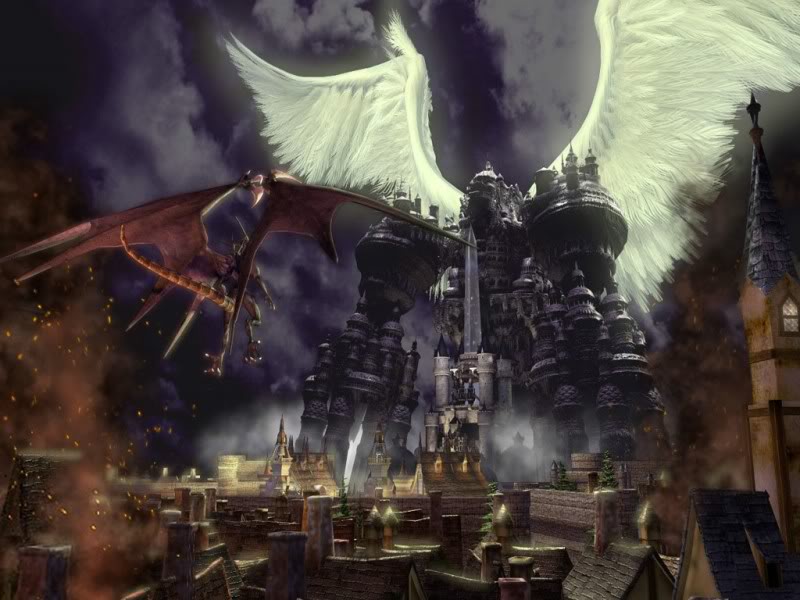
Final Fantasy 9’s artwork and music were also quite impressive. Even though Final Fantasy 9 featured super-deformed characters (which was a throwback to the games of old by the way), it had amazing cinematics and impressively detailed environments. Each room of a particular area oozed with personality, and I feel that Final Fantasy 9 still has some of the most memorable environments to ever grace a video game. You’ll find no stereotypical towns here, as in other RPG series like Dragon Quest.
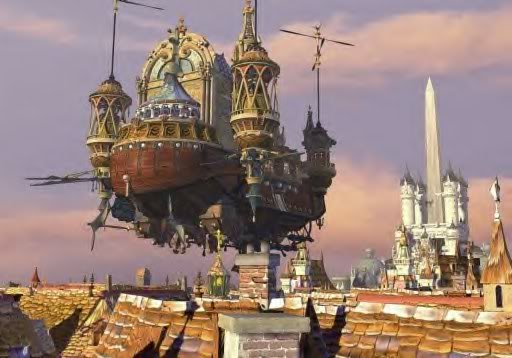
I also felt that the classic tunes were amazing (finally the return of the prelude and prologue), and so were each of the character themes. I’m usually not a huge fan of video game songs with vocals, but I have to say that FF9’s “Melodies of Life” impressed me, far more than FF8’s pop hit called, “Eyes On Me.”
FF9 marked the end of an era–a period in which I was infatuated with RPGs. I still love the genre, and am constantly on the lookout for games with deep storylines, but it’s rare that I’ll find one that I enjoyed as much as Xenogears, Final Fantasy Tactics, or FFIX. I did manage to play three more enjoyable RPGs before the end of the Playstation era however, which consisted of Lunar 2: Eternal Blue Complete, Suikoden, and Suikoden II.
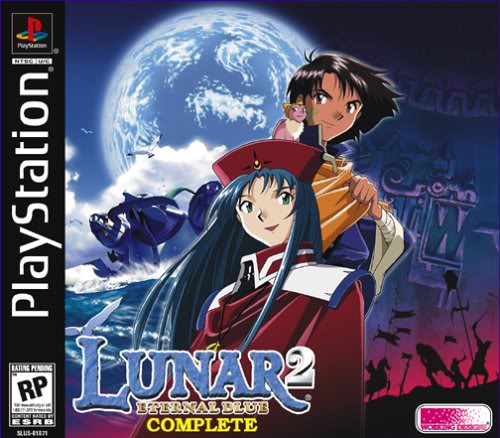
As with the first Lunar remake, I really enjoyed the storyline, dialogue, and characters of Lunar 2. Lunar 2 had more of a darker tone that dealt with whether God (or the goddess Althena in this case) really exists, and discussed the corruption of religious establishments, but I still found it compelling, despite its general lack of light-heartedness.

Once again, this was partly due to the great cast of characters and solid voice acting. The dialogue was humorous, and really gave the characters personality that those in many other RPGs lacked. Personality was also added to the game via top-notch voice acting. I enjoyed the return of John Truit, who voiced a notable villain from the first Lunar, and I found the ultimate enemy of Lunar 2 to have one of the best villain voices to ever grace a video game. The voice actor for the dark god Zophar easily puts to shame wimpy baddies like Seymour.
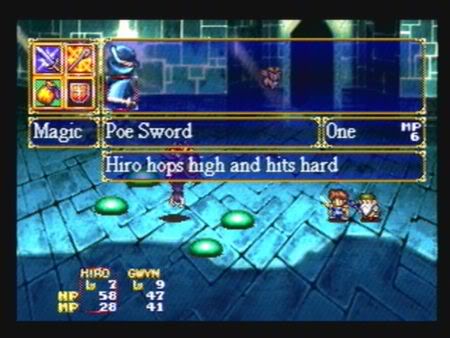
Lunar 2 was certainly a great follow-up to the original Lunar, despite its abundance of random battles, but even more impressive was a title that I originally ignored, called Suikoden. As a frequenter of game stores, I’d noticed Suikoden on the racks before. I knew little about the game, but its terrible box art and horrible description made it an eye-sore that I’d do anything to avoid. Being infatuated with polygons at the time, its old-school 2D visuals also didn’t impress.
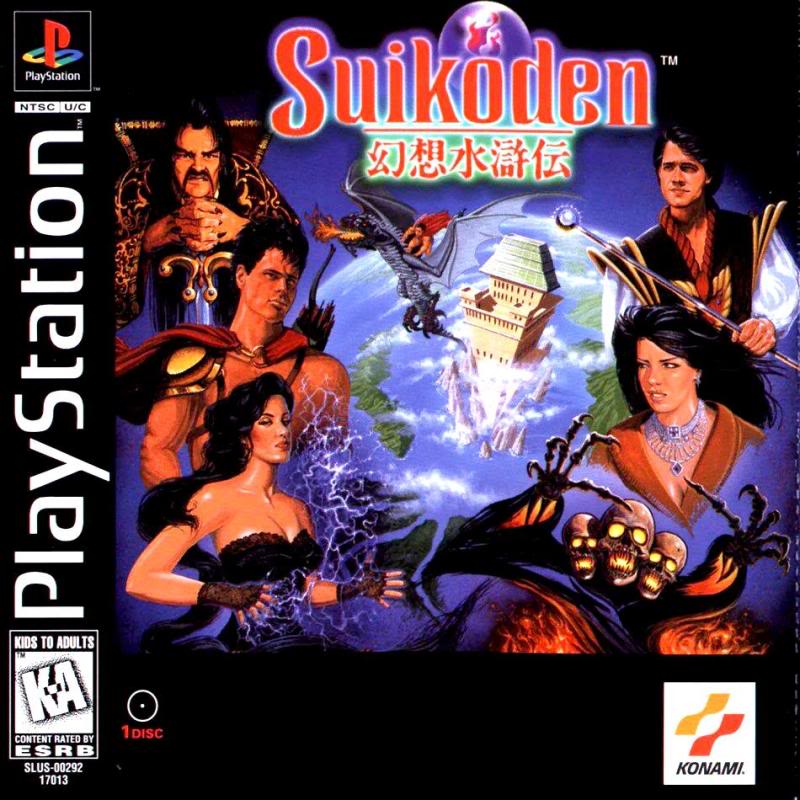
Luckily, a friend on Starcraft talked some sense into me. During the summer I was playing Legend of Mana, he recommended a title called Suikoden. Soon after, I noticed a huge bin full of Suikoden boxes at Toys ‘R Us, so I decided to pick it up, since it was only twenty bucks.
I then went over to Max’s house and spent the night. At six in the morning, we awoke to his mom’s boyfriend cursing loudly and banging pots and pans, but we decided to try out Suikoden anyway. We powered it on and played for about fifteen minutes, but unfortunately, Max wasn’t impressed, so I stuffed it in my closet where it remained in hibernation for a year.
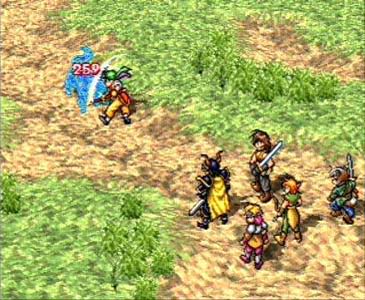
A year later on a day when I was bored, I decided to give Suikoden another shot. I realized that Max may have influenced my opinion regarding the game, so I thought it’d be better to play it solo this time.
This time, I decided to play longer than fifteen minutes. I was treated to an opening where the character had to wait for an audience with the Emperor. This scene was accompanied by a familiar classical music piece, and would forever remain etched in my mind. I soon discovered that my character who was supposed to represent me, was the son of the Emperor’s highest ranking general. My character’s father would do anything to serve the Emperor who had liberated the land, so it was important that I followed in his footsteps.
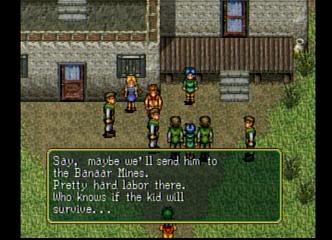
Well, during my initial meeting with the Emperor, I immediately noticed that something was awry. His wife had passed away, but he was accompanied by a mysterious lady, who wielded one of the land’s 27 True Runes. She seemed cold and distant without even saying a word, and it was obvious that she was able to sway the Emperor.
After being dismissed, I was sent on a mission to apprehend some criminals who were evading taxes. I later learned that the Scarlet Moon Empire raised taxes to unfathomably high rates, which was the reason for the increased presence of brigands. My band of characters initially captured these bandits for the purpose of being executed, but they slowly began to learn about the atrocities their empire was committing. Eventually, the main character sides with a liberation army and betrays his own father.
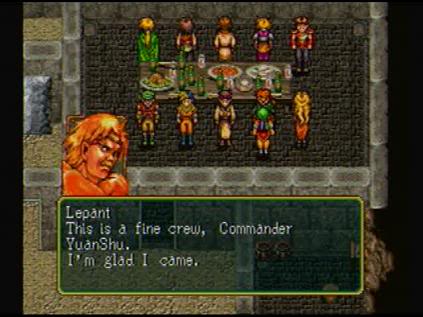
Over the course of the game, your purpose is to gather 108 Stars of Destiny (characters who play an important role in the story), and build a castle that will allow you to liberate individual cities of the empire.
Unlike most RPGs, you’ll find no world-spanning quest here. You also won’t run into many idealistic youth. Instead, you’ll come across an assortment of characters who have various personality quirks. Most of them are quite distinct without having accents, as in Chrono Cross. Some of the individuals who comprise this enormous cast are forgettable, but there are also many likeable characters. What’s even better is that some characters can die, and you even have the choice of letting enemy generals join your army. However, if you’re more of a vengeful individual, you can execute swift justice. You can’t make as many choices as in a recent Bioware RPG, but I loved the mature, regional narrative, and the rush received from liberating territories.
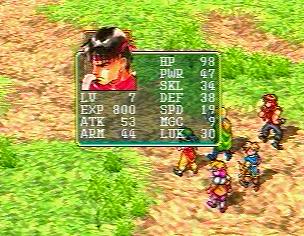
Building up your own castle and recruiting characters is quite fun, but I also loved Suikoden because of its soundtrack. The unique instruments utilized, and the brilliant Suikoden theme set the series apart from many other RPGs. At the time of its 1996 release, the sound quality was leagues better than that found in most other 32-bit games, so Suikoden was truly something special.
Unfortunately, Suikoden’s bland visuals didn’t impress, but this was remedied in its sequel, which is often considered the best game in the series. Suikoden II may have featured amazing 2D visuals and animations, but it became one of my favorite Playstation RPGs for other reasons.
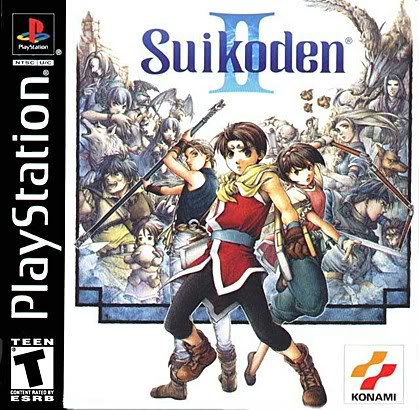
Once again, what I loved most about Suikoden II was its mature narrative and characters. It may have featured a piss-poor translation, but the garbled text couldn’t hide the wonderful storyline that lurked beneath.
Unlike the first Suikoden, Suikoden II began with a bang. You, and your friend Jowy are soldiers for the Highland army, who’re preparing for battle in camp. The Highland Army needed an excuse to attack the Jowston City States, which bordered their southern flank. Unfortunately for you, the army decided to burn down the camp in which you were positioned, and they framed your character and Jowy as traitors. Your character is a lowly commoner, while Jowy belongs to an aristocratic family, but that doesn’t change the fact that both characters are sentenced to a humiliating public execution.
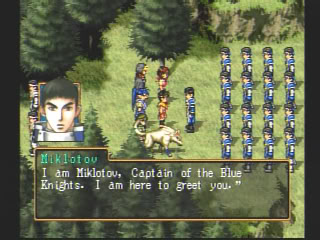
Thankfully, one of the most likeable characters from the original Suikoden named Viktor decides to show up and cut you loose. After you and Jowy make your escape, Viktor hires you on to do chores, while you consider joining a new liberation army. You’re tasked with getting the southern states to form an alliance, but like France and Britain during World War II, they decide to squabble instead of uniting against a dangerous aggressor.
Unfortunately, during one of your expeditions, you have little hope of escaping from the enemy, and Jowy decides to sacrifice himself to give you and your sister a hope for a better future.
*Skip the next four paragraphs to avoid major spoilers*
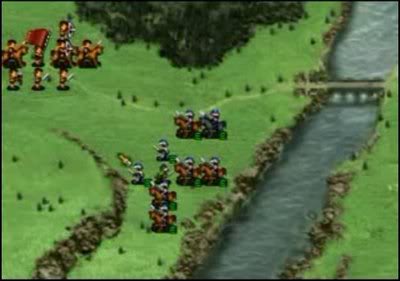
Jowy was originally united with you in fighting the brutal leader of the Highland army named Luca Blight. Luca Blight is one of the most vicious, inhuman enemies to ever grace a video game. When he raids villages, he burns them down and forces women and children to grovel at his feet before slaying them. Unfortunately, you later discover that Jowy survived and decided to side with this monster. His intentions are initially unclear, but perhaps Jowy had his family’s interests at hand all along.
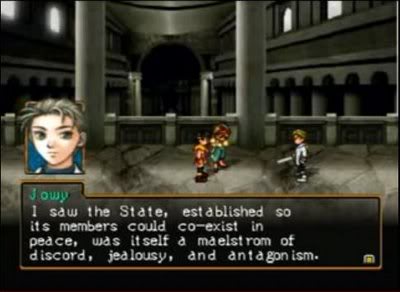
Later in Suikoden II after you’ve built a castle and recruited several party members, you’ll take on the demonic Luca Blight. He actually feels like an incredibly powerful final boss, because it takes three ambushes full of six party members each, hundreds of arrow wounds, and a final duel between him and your main character to take him down. At this point, you think the game might be over, but it really isn’t.
Sadly, your former friend Jowy decides to continue the war. Like you, he believes in peace, but he believes that it can only be achieved through different means. Instead of liberating the land, Jowy believes that true peace can only be attained by one side engulfing the other. Even though this is a fairly basic concept, many modern leaders including George W. Bush believe in this ideal.
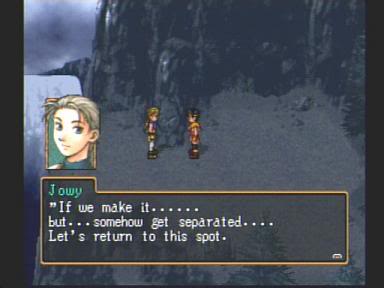
Part way through the experience, there’s a tragic experience that involves you, your sister, and Jowy, but unfortunately, his temporary change of heart isn’t permanent. I actually felt that this tragedy involving the death of an important character was far more dramatic than Aeris’ death in FF7. Suikoden II’s story and events generally felt far more convincing than those of its contemporaries.
*End of spoilers*
Well, once again, I’ve covered a variety of influential games, but this time, most of them were RPGs. There were a few more games of this era that I eventually went back to (like Paper Mario and Majora’s Mask), but none left as great of an impact on me as the games I listed above. I’ll forever remember classics like Chrono Cross, Lunar Silver Star Story, and Final Fantasy IX.
If you’re not done reading about my extensive experience with video games, stay tuned for the next episode that’ll feature my foray into online gaming.
VentureBeat's mission is to be a digital town square for technical decision-makers to gain knowledge about transformative enterprise technology and transact. Learn More
